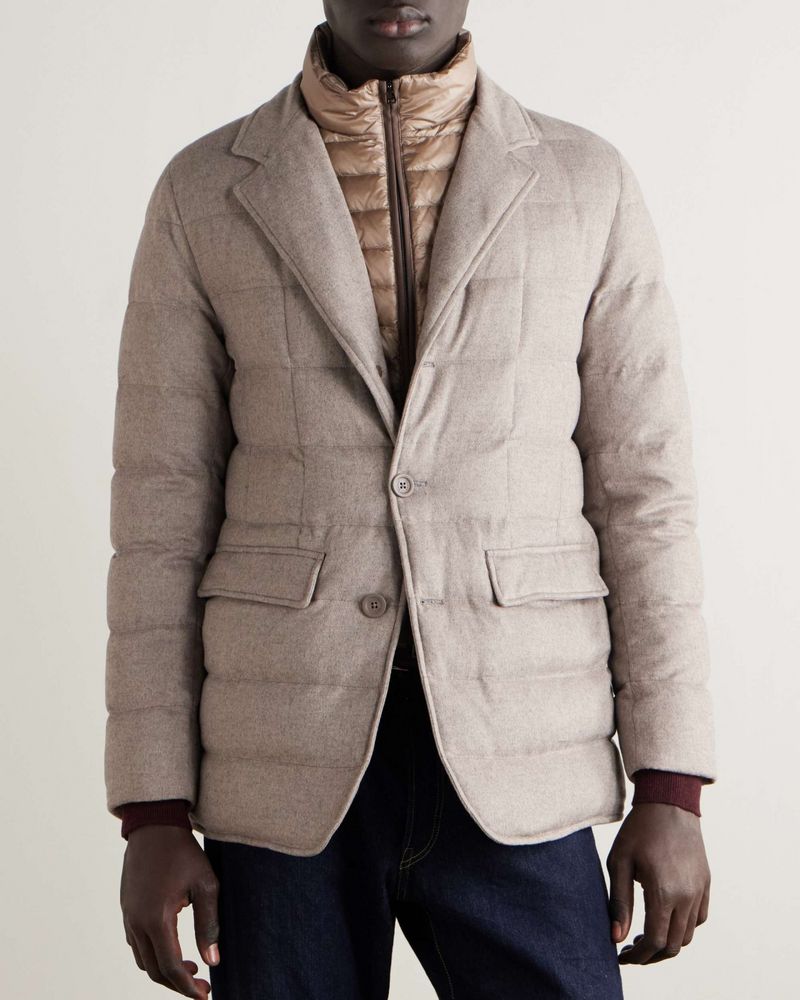THE JOURNAL

A down jacket opens up a lot of possibilities. The question is: which one should you go for? “It’s a choose-your-own-adventure type of moment,” Lauren Cochrane, senior fashion writer for The Guardian and author of The Ten, says of the range of options currently available out there. “The puffer is now so much a part of the fashion landscape that there’s loads of versions to look to. A classic, like a North Face Nuptse, is still good – or a statement one, like a Burberry check, is fun.”
Whether it’s the retro ruggedness of a coat purpose-built for the planet’s most demanding conditions or a wavy spin on a rarified label’s signature motif that draws you in, the key detail here is which “out there” we are talking about. The universal appeal of the down jacket has made it the default coat of the current era. You really could wear one anywhere – and not necessarily a terrain with more vertical elevation than your local high street.
Elevation, though, is something to consider. And not just in relation to metres above sea level, but in terms of “luxury”. As with many practical items of menswear before it, the down jacket has found itself a fixture of the fashion industry, with designers delivering examples that are, well, a cut above.
“We’ve seen bold colours for a while now, but more recently, there are a lot more metallic options that are certified showstoppers,” says Benedict Browne, Style Director at MR PORTER. “Moncler is the obvious one, particularly with its collaboration with A$AP Rocky, but also BEAMS PLUS and Casablanca have shiny options that are more accessible.”
To his mind, the puffier puffers are best deployed in the mountains. “A lighter down jacket is still very practical for winters in the city,” Browne says. “They’re the perfect garments for weekend strolls, where you need that slight edge of urban style with all the added protection from the elements. I personally view them as being casual, off-duty garments and wouldn’t wear one with a suit.”
But as mentioned, there are different paths to take when it comes to this adaptable outerwear. “I always think it helps to dress up a down jacket,” says the fashion journalist Ashley Ogawa Clarke. “Puffy and practical as they are, pairing it with other outdoorsy pieces can make it look like you’re part of the local retirees rambling club. A pair of tailored trousers and some boots or Derby shoes is a good way to introduce some tension, which is always a good thing in an outfit.”
“The classic brands do it best,” Cochrane says. “Moncler, The North Face, Canada Goose. I quite like the shiny effect of the Moncler Gliere as a way to look a bit different, but not over the top.”


Cochrane offers Frank Ocean as an “example of how to do colour and make it look low-key”. Although, Gorpcore pioneer he may have been, the Grammy-winning singer-songwriter was not the first to wear a down jacket. That would be the Australian chemist George Finch, who is regarded as the originator of the style, more than a century ago.
Finch was born and grew up in the small outpost of Orange, New South Wales. His first taste of mountain air came at the age of 14, summiting Mount Canobolas (Gaanha Bula), an extinct volcano to the southwest of his hometown. An education in Switzerland and Paris offered extracurricular outings in the European Alps, where he would spend weekends on unguided treks up the Eiger and Matterhorn (as well as illicitly scaling Notre Dame Cathedral one night with his brother, Max).
This pastime became such a dominant feature in Finch’s life that his 1970 obituary in The Times described him as “one of the two best alpinists of his time” – his contemporary and friendly rival George Mallory being the other. Both Georges had in fact taken part in the 1922 expedition to Mount Everest where Finch debuted his creation, an “eiderdown coat”, custom made from a bright green material more typically used for hot-air balloons.
On this expedition, Finch stood out even before donning his prototype. “He was a colonial, he had long hair, which in those days meant it went to his shoulders, and he’d been divorced,” noted Robert Wainwright, the author of Maverick Mountaineer, a biography on Finch.
Standard wear for Western mountaineers at the time stuck rigidly to warm layers worn under the tweeds of the British countryside. In records from the expedition, the expedition secretary describes Finch’s getup as “the most wonderful apparatus that will make you die laughing” – the tension of the down jacket was there from its inception. Only for Finch to later note in his journal: “Everybody now envying… my eiderdown coat, and it is no longer laughed at.”
Mallory’s fate was sealed two years later on Everest’s treacherous North Face, where he wore a then state-of-the-art Burberry gabardine climbing suit. As for Finch, for all his achievements in mountaineering, the down coat might be his lasting legacy. As well as a reminder that a Burberry check might not be entirely out of place on a puffer – whether or not it is worn at altitude.